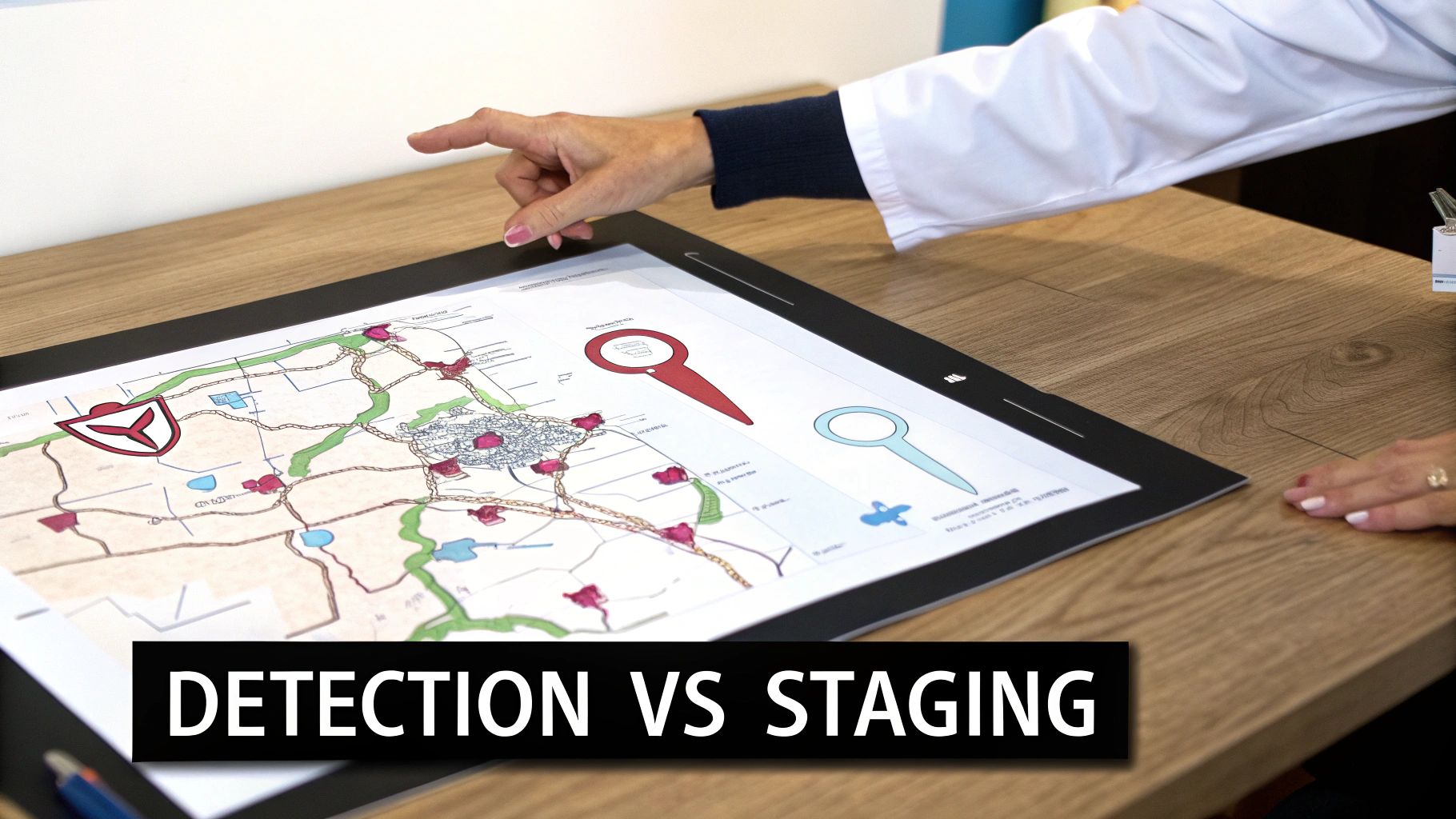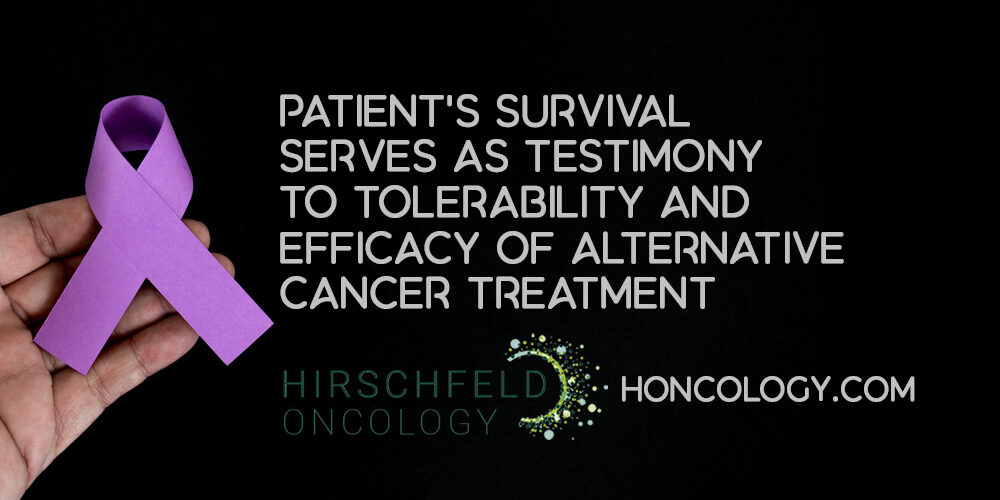Yes, a CT scan can often spot signs of ovarian cancer, but it's not a screening tool used for the general population. Think of it less as a first-line detective and more as a crucial investigator called in once symptoms appear. It gives us a detailed map of the abdomen and pelvis, helping assess the size and shape of a potential tumor and, importantly, whether it has started to spread.
The Role of CT Scans in Finding Ovarian Cancer

When a patient comes to us with persistent bloating, pelvic pain, or strange digestive issues, we need to see what’s going on inside. A Computed Tomography (CT) scan is one of our most powerful tools for this. It uses a series of X-rays from different angles to create cross-sectional images—like looking at individual slices of a loaf of bread to see the whole picture.
By studying these detailed "slices" of the abdomen and pelvis, a radiologist can pinpoint abnormalities that might point toward ovarian cancer.
A CT scan is particularly good at a few key tasks during this workup:
- Spotting Suspicious Masses: It clearly shows if there's a mass on an ovary, giving us a good idea of its size and general characteristics.
- Finding Fluid Buildup: The scan can easily detect ascites, which is an abnormal collection of fluid in the abdomen. This is often a tell-tale sign of advanced ovarian cancer.
- Checking for Cancer Spread: This is where the CT scan really shines. It gives us a bird's-eye view of the entire abdomen and pelvis, so we can see if the cancer has spread to nearby lymph nodes or other organs, like the liver.
This comprehensive overview is absolutely essential for mapping out what comes next, whether that's a biopsy to get a definitive diagnosis or planning for surgery.
Not a Simple Yes or No Test
It’s really important to understand that a CT scan isn't a simple "yes" or "no" test for cancer. It can show us areas that look highly suspicious, but it can’t tell us for certain if a mass is malignant. Only a biopsy, where a piece of the tissue is examined under a microscope, can confirm a cancer diagnosis. Still, the information from the scan is a critical piece of the puzzle.
CT scans are a cornerstone of modern oncology. With an estimated 20,890 women expected to be diagnosed with ovarian cancer in the United States in 2025, effective imaging is more critical than ever. We know that when ovarian cancer is caught early at Stage I, up to 90 percent of women have successful treatment outcomes. That number drops to less than 40 percent for advanced Stage IV diagnoses, which underscores why this kind of detailed imaging is so vital. You can learn more about the impact of early detection from recent studies to see just how much timing matters.
What Ovarian Cancer Looks Like on a CT Scan
When a radiologist peers at a CT scan, they’re not just looking at a picture; they're searching for specific clues that stand out against the backdrop of normal anatomy. Think of them as detectives, piecing together evidence from a complex, grayscale image. A healthy ovary is typically a small, oval-shaped structure, but a cancerous one often looks dramatically different.
One of the most telling signs is an ovarian mass with solid components. Benign cysts are usually simple, fluid-filled sacs that look smooth and uniform on a scan. A cancerous tumor, on the other hand, is often irregular. It might have thick walls, solid nodules growing within it, or a jumbled mix of cystic (fluid) and solid parts. That kind of complexity is a major red flag.
Identifying Key Visual Clues
The real power of a CT scan is its ability to see beyond the ovary itself. It gives us a bird's-eye view of the entire abdomen and pelvis, revealing other tell-tale signs that the cancer might have spread. Radiologists are trained to hunt for these secondary indicators, which are crucial for understanding the true extent of the disease.
These signs often include:
- Ascites: This is the medical term for an abnormal buildup of fluid in the abdominal cavity. On a CT, this fluid shows up as a dark, uniform gray area surrounding the organs. A significant amount of ascites is very strongly associated with ovarian cancer.
- Peritoneal Thickening: The peritoneum is the thin, delicate membrane that lines the abdominal wall and covers the organs inside. Cancer can make this lining thick, irregular, or studded with small nodules. Spotting this suggests the cancer has already moved beyond the ovary.
- Omental Caking: Hanging down from the stomach is a fatty apron of tissue called the omentum. If cancer cells spread there, they can cause it to become thickened and matted into a mass, a classic sign known as "omental caking."
A CT scan doesn't just show a single tumor; it tells a story about the cancer's behavior. The presence of ascites or peritoneal changes provides critical context, helping oncologists understand how aggressive the cancer is and where it has traveled.
Piecing the Puzzle Together
The radiologist's job is to synthesize all these visual clues—the complex mass, the fluid, the thickened tissues—to form an overall impression. Each piece of evidence helps build a case for or against a cancer diagnosis. For example, a small, simple-looking cyst with no other suspicious findings is almost certainly benign.
But a large, solid ovarian mass combined with ascites and omental caking? That picture is highly suspicious for advanced ovarian cancer.
This detailed mapping from the scan is the first step toward accurately staging the disease, which is absolutely essential for creating an effective treatment plan. While the CT provides this vital roadmap, it’s crucial to remember that only a biopsy can give a definitive diagnosis. To understand the complete diagnostic journey for this disease, you can find more information in comprehensive ovarian cancer resources. This knowledge helps create a full picture for patients and their families as they figure out what comes next.
How CT Scans Compare to Other Imaging Tests
While a CT scan gives us an invaluable wide-angle view of the abdomen, it’s just one piece of the diagnostic puzzle. No single imaging test tells the whole story. Instead, oncologists piece together information from several different scans, each offering a unique perspective.
Think of it as assembling a team of specialists for a complex case. Each one brings a different expertise to the table, and together, they build a comprehensive picture of what's happening.
A transvaginal ultrasound is often the first step when a patient comes in with pelvic symptoms. Using sound waves, it gives an incredibly detailed, close-up look at the ovaries. Its main job is to help us distinguish a simple, fluid-filled cyst from a more complex or solid mass that might be concerning.
Adding Layers of Detail
If that initial ultrasound reveals something suspicious, we'll often need more specific information. That's when an MRI or PET scan might come into play. Each of these tests answers different questions, helping us build a more complete and accurate diagnostic assessment.
MRI (Magnetic Resonance Imaging): An MRI uses powerful magnets and radio waves to create exceptionally detailed images of soft tissues. We bring in this "specialist" to get a better look at a mass found on an ultrasound or CT. It gives us a clearer picture of its internal structure, all without using any radiation.
PET (Positron Emission Tomography) Scan: A PET scan adds a different dimension entirely. It doesn't just show us anatomy; it shows us function. By highlighting how metabolically active different cells are, it can help pinpoint cancer, as malignant cells tend to be much more active than normal tissue.
The infographic below highlights some of the key signs—like the shape of a mass, fluid buildup, and tissue thickening—that radiologists are trained to look for on a CT scan.

Putting these visual clues together helps us create a much clearer understanding of what might be going on inside the pelvis and abdomen.
To make these differences clearer, here's a quick breakdown of how each imaging test fits into the diagnostic process for potential ovarian cancer.
Imaging Tests for Ovarian Cancer Compared
Ultimately, each test has its own strengths and weaknesses. The key is knowing when and how to use them together to get the most accurate diagnosis.
The Power of Combination
Because no single test is perfect, combining different imaging methods is standard practice. This multi-modal approach consistently gives us a much higher degree of accuracy than we could ever achieve by relying on one scan alone.
By layering the findings from an ultrasound, CT, and sometimes an MRI or PET scan, your medical team can construct the most accurate possible assessment before recommending a biopsy, which remains the only way to definitively confirm cancer.
Recent studies really drive home the value of this combined approach. For instance, in patients under 50, a PET/CT scan alone had a 79.57% specificity for detecting ovarian cancer. That's good, but when combined with a simple blood test like CA125 in an automated system, that specificity jumped to an impressive 97.79%.
This is a huge clinical advantage. Higher specificity means fewer false positives, which translates to less unnecessary stress and anxiety for patients. You can read more about these findings on ovarian cancer detection to see how this research is making a real difference.
To learn more about how we integrate the latest diagnostic advancements into patient care, explore the ongoing oncology research at Hirschfeld Oncology.
Understanding Detection Versus Cancer Staging

It’s easy to mix up "detecting" a tumor with "staging" the cancer, but in oncology, these are two very different—and equally critical—jobs. Getting a handle on this difference is the key to understanding why a CT scan becomes so indispensable once ovarian cancer is suspected.
Detection is just what it sounds like: the initial act of finding an abnormality. A transvaginal ultrasound, for example, might be the first test to spot a suspicious mass on an ovary. It confirms something is there that shouldn't be, but that finding opens up a flood of new questions.
This is where staging takes over, and it's where the CT scan truly shines. Staging isn't just about finding the tumor; it's about figuring out its exact location and, crucially, how far it has spread throughout the body.
The CT Scan as a Strategic Map
Think of a CT scan as a high-tech map of your body's interior. It gives your oncology team a detailed, cross-sectional view of your chest, abdomen, and pelvis, almost like looking at individual slices to see the whole picture.
This comprehensive overview is essential for answering the strategic questions that will define your entire treatment plan.
The scan helps clarify:
- Is the cancer confined? Is it completely contained within one or both ovaries?
- Has it spread locally? Has the cancer moved into nearby pelvic organs, like the fallopian tubes or uterus?
- Are lymph nodes involved? Have cancerous cells invaded the regional lymph nodes?
- Has it spread to distant sites? Have cancer cells traveled to faraway organs, like the liver, lungs, or the lining of the abdominal cavity (the peritoneum)?
Answering the question "can a CT scan detect ovarian cancer" goes beyond just spotting a tumor. Its most critical role is mapping the cancer's spread, which is the foundation of accurate staging and effective treatment planning.
The answers to these questions are what allow us to determine the cancer’s stage. This is the single most important factor in charting the right course of action. The stage—typically numbered from I (localized) to IV (advanced)—directly influences every decision, from what kind of surgery is necessary to whether chemotherapy should come before or after.
Without the detailed map a CT scan provides, oncologists would be working with an incomplete picture. It transforms a situation full of unknowns into a clear, actionable plan, giving your care team the information needed to design a precise strategy for your specific diagnosis. This is what makes it such a vital tool in the fight against ovarian cancer.
Why We Don't Use CT Scans for Routine Ovarian Cancer Screening
It’s a perfectly logical question: if a CT scan is so good at mapping out what’s happening inside the body, why don’t we use it for routine ovarian cancer screening, the way we use mammograms for breast cancer? The answer comes down to a careful balancing act between benefits and potential harm, especially when we're talking about testing millions of healthy people.
First and foremost, ovarian cancer is relatively rare in the general population. Because of this, the significant downsides of mass CT screening just don't justify the potential upside. One of the biggest concerns is radiation. The dose from a single scan is small, but the cumulative effect of repeated scans over a person’s lifetime is something doctors take very seriously.
Then there's the problem of false positives. A CT scan might spot a totally harmless ovarian cyst or some other benign issue, flagging it as suspicious. This can set off a chain reaction of anxiety, more tests, and sometimes even invasive procedures like biopsies—all for something that was never cancer to begin with.
The Problem with Screening for a Less Common Cancer
For any screening test to be truly effective for an entire population, it has to be exceptionally accurate. The lifetime risk of a woman in the United States developing ovarian cancer is just under 1.3%, or about 1 in 78. To avoid causing more problems than it solves, a screening test would need to be almost perfect. In fact, research shows that for a test to be viable for population-wide screening, it needs a sensitivity over 75% and a staggering specificity of over 99.7%. You can discover more insights about these screening test standards in this detailed overview.
Here’s a quick breakdown of why routine CT screening isn't practical:
- Radiation Exposure: Each scan adds a small dose of radiation, and the risk from yearly screening over many years is a real concern.
- High Cost: CT scans are expensive. Using them for widespread screening would create an enormous financial strain on the healthcare system and individuals.
- The False Positive Trap: Scans often pick up non-cancerous abnormalities, leading to unnecessary stress and invasive follow-up procedures for people who are perfectly healthy.
A CT scan is a powerful diagnostic tool, not a screening one. It shines when used strategically—for someone who already has symptoms or a known risk factor. In those cases, its benefits clearly outweigh its potential harms.
Ultimately, even a CT scan can't give a final diagnosis; only a biopsy can definitively confirm if cancer cells are present. That’s why it remains a crucial tool for investigating symptoms and staging confirmed cancer, but not for broad, preventative screening. This targeted approach ensures we use this powerful technology where it can truly make a difference.
What to Do After Your CT Scan Results

Getting your CT scan results back can be a nerve-wracking experience, whether the report is clear or raises new questions. It's important to see the scan for what it is: a crucial piece of information, but not the final word. Think of it as a detailed map that helps your medical team figure out the best route forward.
If the radiologist's report points to a suspicious mass on an ovary or other findings that need a closer look, your doctor won't waste any time. The immediate goal is to launch a more focused investigation to figure out exactly what's going on.
Putting the Pieces Together
This next phase is all about building a comprehensive picture of your health. Your team will likely recommend a few more tests to get the clarity needed to make an informed diagnosis.
Here’s what you can typically expect:
- Blood Work: A CA-125 blood test is almost always one of the first steps. While it's not a standalone cancer detector, high levels of this protein can be a red flag, especially when paired with concerning imaging results.
- Specialist Referral: You’ll likely get a referral to see a gynecologic oncologist. These doctors are the experts in cancers of the female reproductive system. They have the specialized training to interpret your results accurately and oversee your care.
- Biopsy Planning: At the end of the day, the only way to confirm if a mass is cancer is to look at the cells directly. A biopsy, where a small tissue sample is taken and analyzed by a pathologist, provides the definitive answer.
A referral to a gynecologic oncologist is non-negotiable. Their expertise is vital for everything from reading complex scans to determining the right type of biopsy and, if needed, the best course of treatment.
Here at Hirschfeld Oncology, we guide patients throughout NYC through this entire process. If you’ve received CT scan results that worry you, getting a second opinion from a specialist is the most important thing you can do for yourself. We're here to help you make sense of your scan, arrange the right follow-up tests, and develop a clear plan tailored to you.
Your Questions About CT Scans, Answered
When you're dealing with a potential diagnosis, medical tests can feel overwhelming. You've got questions, and you deserve clear, straightforward answers. Here’s what patients most often ask about CT scans in the context of ovarian cancer.
If My CT Scan Is Normal, Can I Be Sure I Don’t Have Ovarian Cancer?
A normal CT scan is certainly good news, but it isn't a 100% guarantee. The reality is that technology has its limits.
A CT scan might not be able to detect very small, early-stage tumors. Think of it like trying to find a tiny pebble on a vast beach from a distance—until it's a certain size, it just won't show up on the image. That's why your symptoms are so critical. If you're still experiencing persistent bloating, pelvic pain, or feeling full when you've barely eaten, don't ignore it. It’s essential to keep talking to your doctor. They might suggest more watchful waiting or other tests to get the full story.
Is It Better to Have a CT Scan with Contrast Dye?
Yes, almost always. Using an intravenous (IV) contrast dye is like turning on a high-powered spotlight in a dim room. It makes everything clearer and helps the radiologist see details that would otherwise be missed.
Specifically for ovarian cancer, the contrast agent is a game-changer because it:
- Defines the Mass: It helps distinguish between solid components and fluid-filled cysts within a tumor.
- Highlights Blood Flow: Cancerous tumors often develop their own blood supply, and the contrast dye makes these areas light up, signaling suspicious activity.
- Reveals Spread: It makes it much easier to spot if the cancer has spread to nearby organs or the lining of the abdomen (the peritoneum).
How Long Until I Get My CT Scan Results?
Waiting for results is often the hardest part. Generally, a radiologist will read your scan and send a full report to your doctor within 24 to 48 hours. In urgent cases, your doctor might get a preliminary call from the radiologist much sooner.
Your physician will then set up a time to go over the report with you. This is so they can translate the medical jargon, answer your questions directly, and talk you through what comes next.
This deliberate process ensures you get a thoughtful, complete interpretation of your scan. If you're looking for more guidance on navigating medical tests, our collection of questions answered resources can be a huge help.
At Hirschfeld Oncology, we believe in providing clarity and compassionate direction. If you're in the NYC area and have questions about your scan results or need a second opinion, we're here to help you understand what it all means and move forward with confidence. Contact us today to schedule a consultation.





.png)


.png)
.png)




